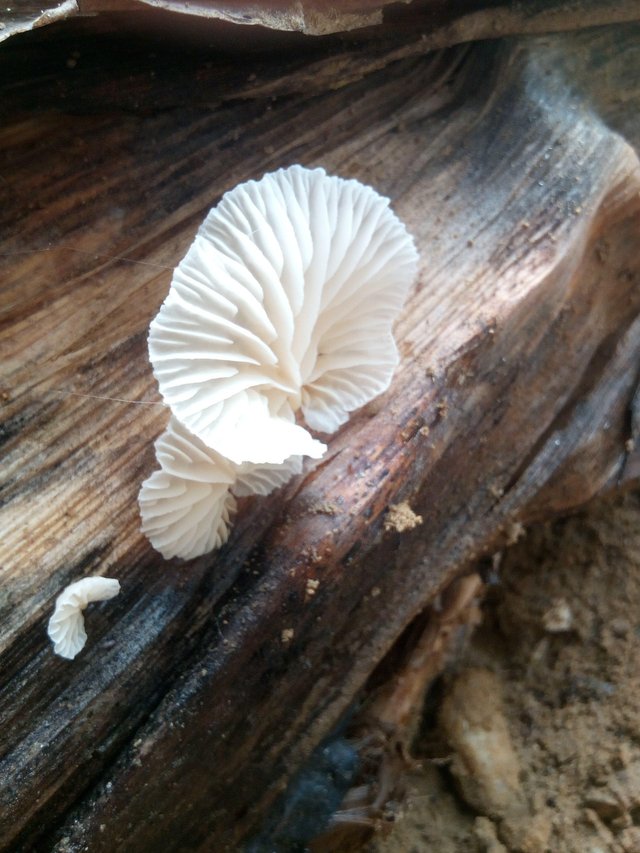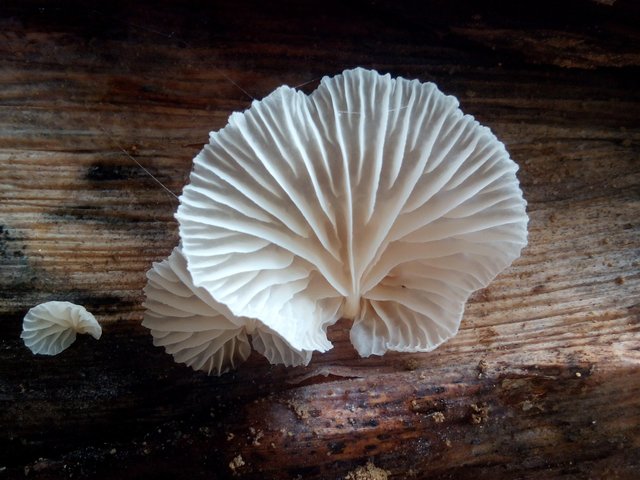Oyster mushroom (Pleurotus ostreatus) is a food fungus from the Basidiomycota group and belongs to the Homobasidiomycetes class with the general characteristics of the white fruit body to the beige and the semicircular hood resembling an oyster shell with a slightly concave center. Oyster mushroom is still a relative with Pleurotus eryngii and is often known as King Oyster Mushroom.

The oyster mushroom body has a sideways grove (Latin: pleurotus) and oyster-shaped (ostreatus) so that the oyster mushroom has the binomial name Pleurotus ostreatus. The hood part of the fungus changes color from black, gray, brown, to white, with a nearly slippery surface, a 5-20 cm diameter with smooth edges with a slightly curved hood. In addition, oyster mushrooms also have stem-shaped spores measuring 8-11 × 3-4μm and white miselia that can grow quickly.
In the wild, oyster mushrooms can be found almost throughout the year in the cool mountainous forests of the region. Fruit bodies seen overlapping on the surface of decayed tree trunks or stems of tree trunks that have been felled because the oyster mushroom is one type of wood fungus. For that, when want to cultivate this fungus, the substrate must be made to consider the natural habitat. Common media used to breed oyster mushroom is sawdust wood which is waste from sawmill.
In general, oyster mushrooms, Pleurotus ostreatus, undergo two types of breeding in its life cycle, ie asexually as well as sexually. As well as asexual reproduction of fungi, asexual reproduction of basidiomycota generally occurring through an endogenous spore pathway in its spore or sporangium sac, its asexual spores called conidiospores are formed in conidium. While sexually, reproduction occurs through the unification of two types of hyphae which act as male gametes and females form a zygote which then grows into an adult primodia. Sexual spores in white oyster mushrooms, also called basidiospores located in the basidium sac.

At first the basidiospores mimic form a monocharyotic mycelium, the mycelium with a haploid nucleus. The mycelium continues to grow until the hyphae in the mycelium fuses with other compatible hyphae causing plasmogamy to form a dikaryotic hyphae. After that when environmental conditions permit (temperature between 10-20 ° C, moisture 85-90%, sufficient light, and CO2 <1000 ppm) then the fruit body will be formed. The formation of the fruit body accompanied the occurrence of kariogami and meiosis in the basidium.
The meiotic haploid nucleus then migrates to tetrad basidiospores in the basidium. The basidium is located on a slab or bulkhead in a large number of adult mushrooms (lamela). From this detached spore will develop into a mono-phonic hyphae. This hyphae will lengthen its filaments by forming a forming branch of two nuclei bounded by a septum (one septum a nucleus). Then the mono-mononic hyphae will accumulate to form a white connecting connective tissue called the early mycelium and eventually grow into adult mycelium (a collection of hyphae dikarion). In this stage, hyphae have undergone plasmogami, kariogami, and meiotic stages to form mushrooms. Later, the fungus can now be directly harvested or re-prepared into a parent seed.
Source:
https://www.youtube.com/watch?v=IzjuPl8M2PUNot indicating that the content you copy/paste is not your original work could be seen as plagiarism.
Some tips to share content and add value:
Repeated plagiarized posts are considered spam. Spam is discouraged by the community, and may result in action from the cheetah bot.
Creative Commons: If you are posting content under a Creative Commons license, please attribute and link according to the specific license. If you are posting content under CC0 or Public Domain please consider noting that at the end of your post.
If you are actually the original author, please do reply to let us know!
Thank You!
Downvoting a post can decrease pending rewards and make it less visible. Common reasons:
Submit